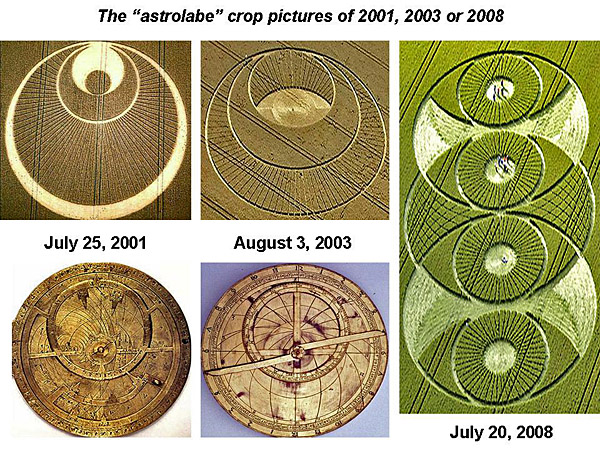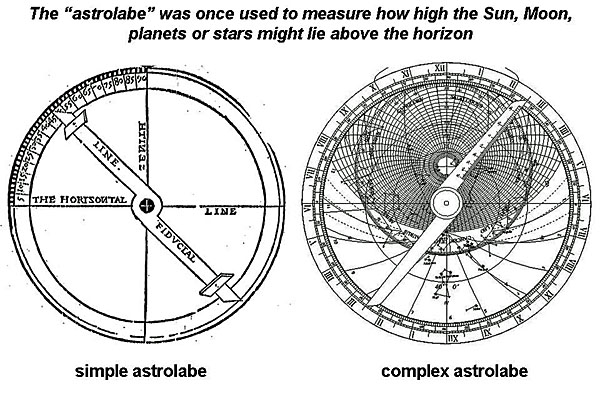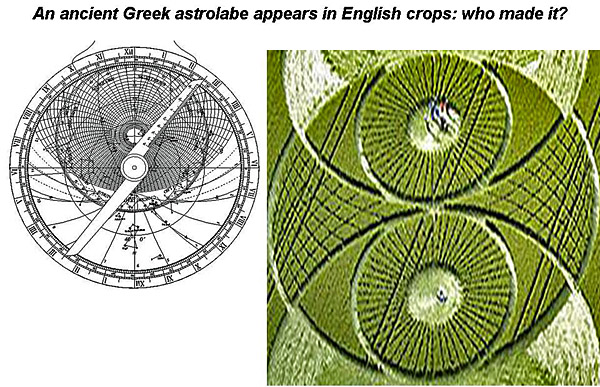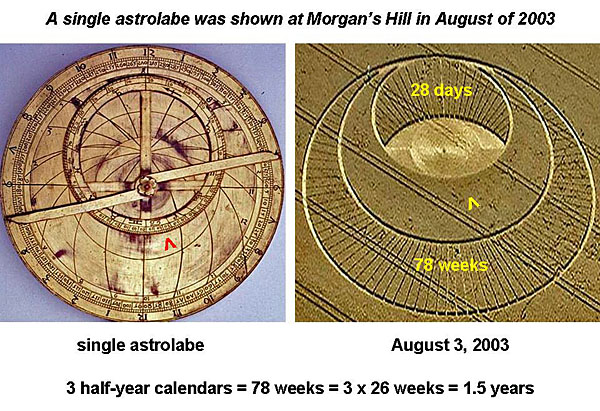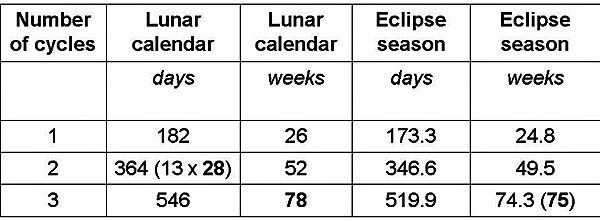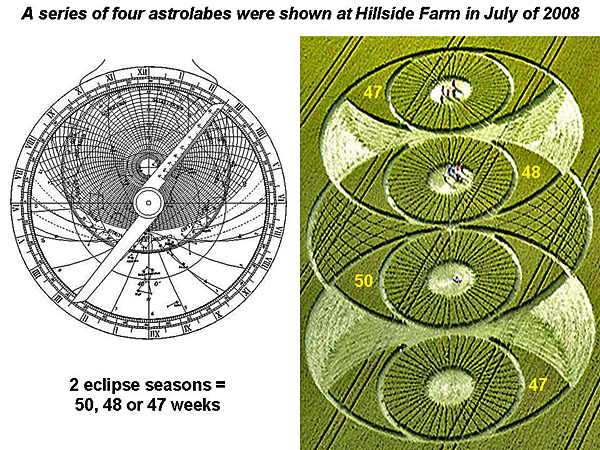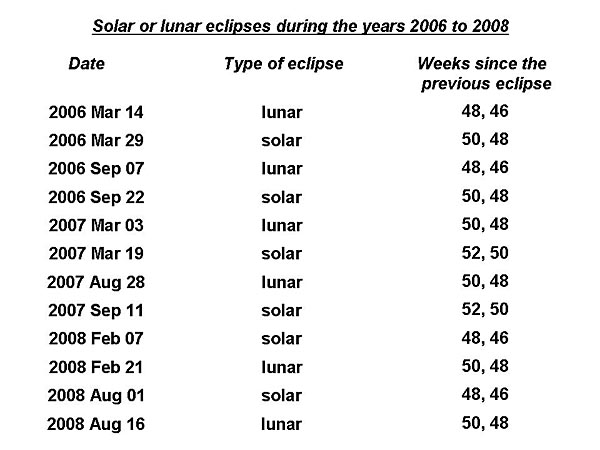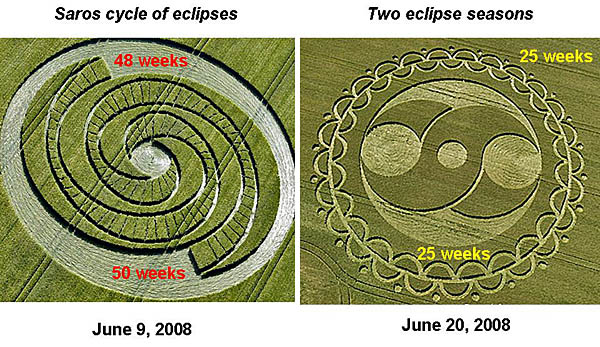|
The “astrolabe” crop pictures of 2001, 2003 and 2008: another lesson in ancient astronomy for the modern inhabitants of Earth! The underlying nature of modern crop pictures has long remained an enigma. Who could be making such field images, and why? In order to address that problem with any kind of scientific rigour, we have no choice but to study those pictures in close detail, in order to determine what they might be trying to tell us. Modern crop pictures have been appearing en masse since the summer of 1990 in Wiltshire (see Crop Circle Archives), yet some of those pictorial messages are still not fully understood. For example, it was only recently discovered that a well-known crop picture from 2001, namely the Cambridgeshire “maze”, showed detailed images from an ancient Greek astronomical computer known as the Antikythera device (see time2007u.html or time2007w.html). Why was that discovery not made sooner? Simply because the images that were shown in a field outside of Cambridge, during the summer of 2001, were not collected by leading scientists on Earth until 2005 or 2006! Thus, it would have been impossible for any crop circle researcher to correctly interpret that “maze” picture when it first appeared, because the detailed information which was shown there came from five years in the future. First the Antikythera device, now astrolabes Now when Marina Sassi, an Italian crop circle researcher, read those two new articles on the Antikythera device, and consulted with local experts, she soon found that a second kind of Greek astronomical device had also been drawn in English fields. But once again, no one had noticed! That second kind of astronomical device is known as an “astrolabe”.
Three separate crop pictures from 2001, 2003 or 2008 all seem to show a generalized “astrolabe” motif. But what exactly is an astrolabe? And why was it so important to astronomers on early Earth, before the discovery of the telescope? The astrolabe: an ancient Greek instrument for measuring sky locations of the Sun, Moon, planets or stars Today the astrolabe has been forgotten by all but a few scholars (see www.astrolabes.org or Astrolabe). But once it was the mainstay of Greek, Roman or Islamic astronomy. “The origins of the astrolabe lie in ancient Greece. Apollonius studied its mathematical projection in 225 BC. Hipparchus, who lived on Rhodes, also helped to develop the theory of an astrolabe. Claudius Ptolemy wrote about in his book Planisphaerium in 150 AD, and may have used such an instrument himself” (see www.mlahanas.de/Greeks/Astrolabe.htm or www.astrolabes.org/history.htm). The astrolabe was a finely fashioned astronomical instrument, which could measure accurately the sky location (“altitude”) of any bright object such as the Sun, Moon, planets or stars:
For practical advice on how to use an astrolabe, see AtHomeAstronom. For a brief history of the astrolabe in Greece, Egypt, or Islamic countries, see astrolabe.pdf. The big question: who made those crop pictures? Okay, so we know now that an “astrolabe” as well as the “Antikythera device” have appeared recently in English fields. But the big question remains: who made those crop pictures?
In order to address that question with any kind of scientific rigour, we have no choice but to study carefully what those “astrolabe” crop pictures have to say. Morgan’s Hill of August 3, 2003 One of the earliest “astrolabe” crop pictures appeared at Morgan’s Hill on August 3, 2003 (see morganshill). It showed two large fan-like regions, which were divided evenly into 28 or 78 radial segments respectively:
Its upper region of 28 segments immediately suggests “one lunar month of 28 days”. There are several different kinds of lunar month, which vary in length from 29.5 to 27.2 days depending on what is being measured: (a) periodic changes of lunar phase (the “synodic” month of 29.5 days); (b) return of our Moon to the same location relative to background stars (the “sidereal” month of 27.3 days); (c) periodic variations in the distance of our Moon from Earth (the “anomalistic” month of 27.6 days); or (d) periodic intersections of our Moon with the plane of Earth’s orbit (the “draconic” month of 27.2 days). At Morgan’s Hill, we were apparently being shown a lunar month with 28 days exactly. Such a month was used for calendrical purposes in historical England until the 15th century: "A lunisolar calendar with 13 months of 28 days was used in England until Tudor times. The lunar year thus contained 13 x 28 = 364 days or 52 weeks, while the solar year contained 365 days" (see Lunar_calendar#Old_English_13-month_lunar_year). But how might a lower fan-like region of 78 segments, which was also shown at Morgan’s Hill, fit into this scheme? Well, after three half-year repeats of that lunisolar calendar, it would extend for 3 x 26 = 78 weeks or equivalently 19.5 x 28 = 546 days. Gog Magog of July 25, 2001 Another single “astrolabe” crop picture appeared at Gog Magog Hills, just outside of Cambridge, on July 25, 2001 (see GogMagogHills):
The “maze” crop picture at Gog Magog only two weeks earlier had provided us with a schedule of eclipses (see /time2007u). Hence it seems quite logical that a follow-up picture on July 25 should have shown us 75 radial segments, along with three crescent-shaped symbols to suggest “eclipse”. Thus, solar or lunar eclipses appear periodically on Earth once every six months or 25 weeks. Three such sets of “eclipse seasons” would therefore appear in a total of 3 x 25 = 75 weeks or 1.5 years. Eclipses have been shown quite commonly in modern crop pictures, for example at Lizzano, Italy on June 12, 2008 (see Lizzano or Cerchio Celletta). A brief summary of what we have learned so far So far we have been taught some very basic information about: (i) a 13-month lunisolar calendar with 28 days per month, and (ii) the length of any eclipse season.
Thus, after any interval of 1.5 years, three repeats of a six-month lunisolar calendar will extend for 546 days or 78 weeks, while three eclipse seasons will extend for 520 days or 75 weeks. Hillside Farm of July 20, 2008 By 2008, the general character of those “astrolabe” or “eclipse” crop pictures had become far more complex (see /080808). One of the best examples appeared at Hillside Farm on July 20, 2008 (see westwoods2008):
There we saw four “astrolabes” lined up in a row, each containing a circular fan-like region that was divided evenly into 47, 48, 50 or 47 radial segments for the four examples respectively. What could this mean? Well, those are just the typical number of weeks required to complete two eclipse seasons (unlike the three eclipse seasons shown at Gog Magog). Solar or lunar eclipses during the years 2006 to 2008 In order to clarify the meaning of Hillside Farm even further, let us examine carefully a list of solar or lunar eclipses from the years 2006 to 2008 (see SEdecade2001 or LE2001-2100):
In any year there were two sets of lunar or solar eclipses, separated in time by approximately 25 weeks from one another. Each of those sets is called an “eclipse season”. Now after any two eclipse seasons, a solar eclipse will repeat typically in 50.6 or 45.9 weeks, or equivalently one solar year minus 11 or 44 days. Any lunar eclipse will repeat as plus or minus 2.1 weeks (15 days) away from a solar eclipse. Thus, the four most common values for “weeks since a previous eclipse” were 50.6, 48.5 = (50.6 – 2.1), 48.0 = (45.9 + 2.1), or 45.9. Meanwhile, at Hillside Farm we saw 50, 48 or 47 weeks. Pretty close! Does anyone have a good idea while they showed us the number “47” rather than “46”? Two other crop pictures from 2008 provided us with similar numbers Two other crop pictures from the summer of 2008 seem to unambiguously confirm these interpretations. Thus, West Kennett Longbarrow of June 9 (see westkennettlongbarrow) showed symbols for “50 or 48 weeks”, in the context of shadow paths for eclipses from any 18-year Saros cycle:
Furze Knoll of June 20 (see furze) showed symbols for “25 + 25 = 50 weeks” in any two eclipse seasons of 346 days. Who could be making such amazing crop pictures and why? Who could be making such amazing crop pictures, and why? Most people on Earth today believe that all crop pictures are made by human fakers with rope and boards, late at night when no one is looking (like for Santa Claus or the Easter Bunny). They believe in such a fairy tale, because that is what has been told to them repeatedly in newspapers or on TV. No serious researcher currently believes in the “human faker” hypothesis. It would be like for a geologist to believe in a “flat Earth” theory! But on the other hand, there is no general consensus yet as to whom the real culprits might be. They could be extra-terrestrials, or they could be time travellers. They might come from our future, from our past, or from another space time dimension. They could be material life forms, or they could be spirits? One thing however we know for sure: those unknown crop artists seem to be very smart scientific types, who know quite a lot about the detailed history of planet Earth and its great men, as well as its great scientific achievements. The earliest crop pictures of a complex kind appeared in Wiltshire from 1990 to 1993, and often showed a “dumbbell” shape. Those pictures were not understood at the time, but now we know that they had clear astronomical meanings in terms of planetary conjunctions, oppositions or eclipses (see time2007f). Indeed, during the summer of 1989, Colin Andrews received a strange letter which claimed to be from someone in contact with the crop artists, which said in part (see CheesefootHead-PatDelgado):
“Check your charts when you have
time: Yes, indeed: the same pictorial messages which were just about to be shown in crops from 1990 to 1993, were also in the sky at the same time! A few years later in 1994 or 1995, other astronomical messages of a complex kind appeared in crops, and were analysed by Andy Thomas and Jack Sullivan (see swirlednews.com or Cetus). More recently, we have seen a veritable explosion of astronomical information being given in crops: say with the future prediction of Comet Holmes in 2005 (see time2007h), or with many eclipse science pictures in 2008 (see 080808). Another lesson in ancient astronomy for the modern inhabitants of Earth! In summary, those unknown crop artists seem to be very advanced scientists of some kind, who have a great knowledge of ancient history or culture on planet Earth, especially its astronomy. Consistent with that idea, they showed us in 2001 the “Antikythera device” (see time2007u or time2007w), which was once a Greek astronomical computer. Then in 2001, 2003 or 2008 they showed us the “astrolabe”, which was once a Greek astronomical measuring device. Why are they showing us such things? No one can say for sure, but perhaps just to see if we “catch on”? Before proceeding to give us even more advanced messages? To conclude, those mysterious crop artists have provided with the “astrolabe” crop pictures yet another lesson in ancient astronomy for the modern inhabitants of Earth: but will anyone listen? Have we become so distanced from nature in our large cities, that we can no longer understand or appreciate the night sky above? Harold Stryderight and Marina Sassi P.S. We would like to thank John Dove, Steve Alexander, Nick Nicholson, Stuart Dike or Lucy Pringle for some of the images used here |
